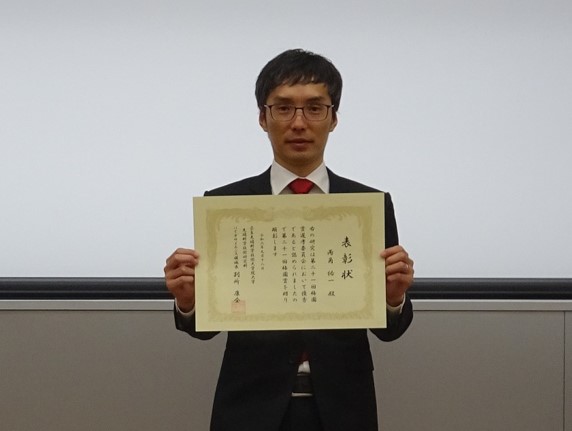第21回梅園賞授賞式が開催されました。
バイオサイエンス領域 植物二次代謝研究室の小牧伸一郎助教と微生物インタラクション研究室の両角佑一助教のお二方が第21回梅園賞を受賞しました。
9月18日に、Rethinkバイオサイエンス領域大講義室(L11)にて授賞式と記念講演が行われ、多くの教職員と学生が参加し、受賞者の功績を称えました。
梅園賞は、梅園基金の設立趣旨に沿って、熱気溢れる時期にバイオサイエンス研究に精進し、バイオサイエンス領域において優れた研究成果(論文発表)をあげた本学の助教あるいはポスドク研究員を顕彰するものです。過去において助教あるいはポスドクとして本学に在籍していた方も選考の対象としてします。対象者が研究の推進に中心的な役割を果たしたと認められる発表論文(2021年6月1日〜2023年5月31日の期間に査読付き国際学術誌に発表されたもの)の学術的価値とオリジナリティの高さに審査の重点が置かれています。受賞者には表彰状と副賞が授与されました。
第21回梅園賞受賞者 小牧伸一郎助教のコメント

この度は梅園賞という素晴らしい賞をいただき、大変光栄に思います。対象となった研究は、ドイツのArp Schnittger教授のもとで始めた細胞周期チェックポイントに関する研究を起点とし、奈良先端大の橋本隆先生、そして現在の所属研究室の峠隆之先生のもとで発展させてきたものです。本研究を行うにあたりサポートしてくださった各先生方、そして研究室の皆様に深く感謝いたします。
小牧伸一郎助教の受賞研究の発表内容(演題と要旨)
収斂進化によるCPC複合体のキネトコア局在機構の獲得
Acquisition of the kinetochore localization mechanism of the Chromosomal Passenger Complex by convergent evolution
Abstract:
The Chromosomal Passenger Complex (CPC) is essential for chromosome segregation during cell division, comprising key proteins like Aurora kinase, inner centromere protein (INCENP), Borealin, and Survivin. Correct CPC localization to the kinetochore is vital for its role in chromosome alignment and segregation regulation. While most CPC components are conserved across eukaryotes, orthologs of the chromatin reader Survivin have been only found in animals and fungi. This raises the question of how its essential role is fulfilled in other eukaryotes. By characterizing proteins that bind to the Arabidopsis Borealin ortholog, we identified BOREALIN RELATED INTERACTOR 1 and 2 (BORI1 and BORI2) as redundant Survivin-like proteins within the context of the CPC in plants. Similar to Survivin, BORIs bind to phosphorylated histone H3, crucial for CPC-chromatin association. However, this interaction is mediated by an FHA domain, a widely conserved phosphate-binding module, instead of a BIR domain found in other Survivin orthologs. We found that the defining feature of Survivin-type proteins is a helix that facilitates complex formation with other scaffold components, while the phosphate-binding domain, necessary for concentration at the inner centromere, evolved independently in different eukaryotic groups. Using sensitive similarity searches, we found conservation of this helical domain between animals and plants and identified the missing CPC component in most eukaryotic supergroups. Interestingly, we also detected Survivin orthologs without a defined phosphate-binding domain, which likely reflects the situation in the last eukaryotic common ancestor.
第21回梅園賞受賞者 両角佑一助教のコメント

この度は栄えある賞を頂き、大変名誉に思います。受賞の対象となった研究は、当時バイオサイエンス領域の教授であった塩﨑一裕学長の研究室で、免疫抑制剤であるラパマイシンを培地に加えると、酵母が通常致死となる高温でも生育できることを偶然みつけたことから始まりました。学長就任以降も継続的にサポートしてくださった塩﨑学長を始め、一緒に研究を進めてきた研究室の皆さんおよび共同研究者の方々に深く感謝申し上げます。この賞を励みに、今後さらに研究を発展させていきたいと思います。
両角佑一助教の受賞研究の発表内容(演題と要旨)
分裂酵母が高温環境下での細胞増殖を自ら抑制する仕組み
Genetic mechanisms restrict fission yeast growth at high temperatures
Abstract:
Cells cease to grow above their permissive temperatures, a phenomenon generally due to protein denaturing and/or heat damage to other cellular components. The fission yeast Schizosaccharomyces pombe, which have been utilized as a useful model organism to explore diverse eukaryotic cellular processes, grows optimally around 30˚C and fails to proliferate at 38˚C and above. Here, we discovered that, in the presence of rapamycin, a specific inhibitor of the TOR Complex 1 (TORC1), fission yeast cells remain viable and proliferate at high temperatures that normally arrest their growth. In addition, mutations to the TORC1 subunit Mip1 and the TORC1 substrate Sck1 significantly improve high-temperature growth in the absence of rapamycin. These results indicate that TORC1, which is well-known as a growth promoting factor, negatively regulates fission yeast growth at high temperatures. For more comprehensive understanding of the regulatory elements that restrict high-temperature growth, we performed genome-wide screens and identified several additional factors that suppress cell proliferation at high temperatures. These findings strongly suggest that the high-temperature growth of fission yeast is impeded by mechanisms even below the temperatures deleterious to cell physiology. Thus, growth arrest at high temperatures may not necessarily be a direct consequence of heat damage to cellular components essential for cell growth.
(2024年09月19日掲載)
 奈良先端科学技術大学院大学
奈良先端科学技術大学院大学